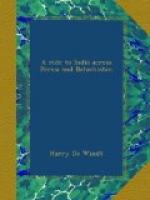[Footnote A: Cossack whips.]
CHAPTER XI.
KELAT—QUETTA—BOMBAY.
We encamped in the suburbs of the city, about a couple of miles from the northern or Mastung Gate, and near the telegraph office, a small brick bungalow in charge of an English-speaking native. There is a single wire laid to Quetta, a distance, roughly speaking, of ninety miles. A terrific hurricane, accompanied by thunder, vivid lightning, and dense clouds of black dust, sprang up about sunset the day of our arrival. Both tents were instantly blown down, and in a few moments reduced to shapeless rags of torn canvas. So great was the force of the wind that it snapped the tent-poles short off, and, tearing them from the ropes, sent the tents flying over the plain as if they had been shreds of tissue paper. We managed, however, to find quarters in the telegraph office, and remained there till our departure, two days later, for Quetta. During the storm the thermometer sank to 50 deg. Fahr., although a few moments before it had marked 78 deg..
Kelat contains—with its suburbs, which are of considerable extent—about 15,000 inhabitants, and is picturesquely situated on the edge of a fertile plain thickly cultivated with wheat, barley, and tobacco. The city is built in terraces, on the sides and summit of a limestone cliff, about a hundred and fifty feet high. This is called the “Shah Mirdan,” and is surrounded at the base of the hill by high mud ramparts, with bastions at intervals, loopholed for musketry. The “Mir,” [A] or palace of the Khan, overhangs the town, and is made up of a confused mass of buildings, which, though imposing at a distance, I found on closer inspection to consist chiefly of mud, which in many places had crumbled away, leaving great gaping holes in the walls. The Mir mounts a few primitive, muzzle-loading cannon, and the citadel is garrisoned by a thousand men, chiefly Afghans, deserters from Cabul, Kandahar, and other parts of the Ameer’s dominions. They are




